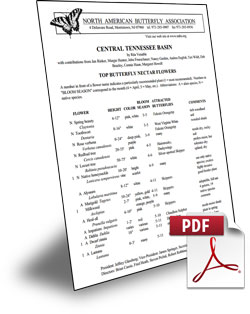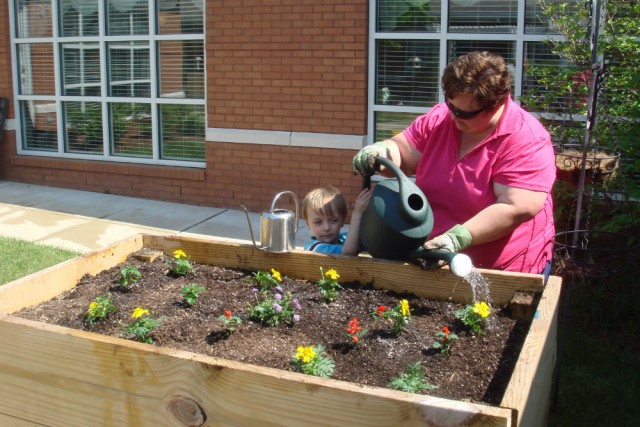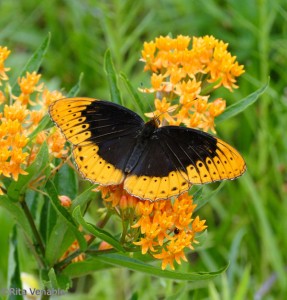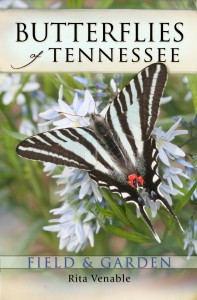You have decided to plant a butterfly garden? Before you put spade to soil, ask yourself these basic questions and consider these steps:
- What are the reasons for this garden? Do I want to attract butterflies for nectaring or egg-laying?
- How much time and money do I have to spend on this project?
- Who will maintain this garden?
- What is my proposed site like?
- Which plants will thrive here?
- What is my focal point in this garden?
- Make a drawing of your proposed garden. Frame the focal point.
- Prepare the soil.
- Plant.
- Mulch.
Clarify Your Reasons
It is important to clarify your reasons for your new garden. This will determine what you plant there. If you are interested in learning more about butterflies beyond observing them feed, you might want to include plans for host plants so you can see different behaviors such as courtship, mating, egg-laying and more. If your main objective is to just provide nectaring plants for adult butterflies and also have flowers suitable for cutting and arrangements, you will plan in different way. You might want herbs for your table or color for your outdoor spaces in addition to your butterfly plants. Consider the different uses of the garden.
Time/Money Considerations
How much money will be needed for soil amendments, plants, mulch and borders? Who will fund this project? Who will have time to help dig and plant the garden initially? Do you want to install the garden all at one time or plant over a period of months? Will plants be donated or will you need to buy them? Could seed be used for some plants in order to save money?
Maintenance
The most important decision to make concerning a butterfly garden is, “Who will take care of this garden?” Without regular watering and weeding, the best butterfly plants available will fail to thrive. Is there a hose or water sprinkler nearby? How much time/week will be required for this garden during the growing season? How many people have committed to weeding and watering? If you find that the time or cost of maintaining a large garden is prohibitive, consider planting a smaller one which can be expanded later, or perhaps even attractive raised beds.
Looking at the Site
It is important to think about the place where you want your new garden to be. How much sunlight does it receive each day? What is the exposure? Will the garden be sheltered from winds by a building, trees or shrubbery? Shelter is very important for butterflies as it will protect them from the elements. Evergreens are good because they provide shelter on days when the weather is variable.
Is the soil adequate or will it need some help? Are there a lot of obstacles there such as rocks, underground utility lines, water lines, etc.? Good soil means healthy plants and healthy plants are best for butterflies. Sometimes it takes years to build up a good soil, but you can still have the garden in the meantime. Ammendments such as compost can be added each year to enhance the soil.
Locate the water source and see what hoses or sprinklers will be needed. If you use native plants, you will have fewer water considerations because the plants are more acclimated to the local conditions. Sprinklers are the least effective way to water because they can wash out the nectar from the plants.
Plant Selection
Please excuse the forthcoming pun, but: There are many plants to choose from, but few will make the final cut!
Indeed, there are a variety of plants that would probably serve well in your garden, but will they WORK HARD? A plant that pulls its own weight is vital.
I like plants that meet several criteria for my butterfly garden. I want a plant that will function as food, shelter or a host plant for the butterflies. I want a plant that will survive in the location and be healthy. I want a plant that is NOT on the invasive plant list for Tennessee. I want a plant that does not have to be fussed over. I want a plant that will provide color, fragrance or interest for the inside of my home. I want a plant that doesn’t irritate my neighbors.
Another consideration that will become even more important in the future is water usage. Try to incorporate as many plants as possible that do not require too much water unless, of course, you have a wet area.
A few plants will meet all of these needs, most of them are natives. A few will meet some of the needs, and may even be used because of sentimental reasons. Some will meet few, if any, needs and these should be eliminated from your plant list. The orange milkweed (Asclepias tuberosa) shown below with a Black Swallowtail, is a strong native plant that provides good nectaring for many butterfly species, is a host plant for the Monarch, does not require much care, is not invasive and should last for many years as it is a periennial. It will spread but can be contained. In the fall, the seed pods add to the dried floral arrangements.
Here is a chart of various species of milkweed you can plant in your garden (each species has particular soil preferences, so you are sure to find one that meets your requirements):
Points To Remember:
Do not use pesticides on the flowers in your butterfly garden. This can kill butterflies in all life stages – egg, caterpillar, chrysalis and adult.
One of the best resources for planning a butterfly garden is found at the following location: Tennessee Central Basin Garden Guide. This guide is geared toward Middle Tennessee, but some of the plants and ideas will carry over into other locations as well.
A New Book by Our Chapter President, Rita Venable
We are so proud of Rita, and pleased to mention her own book all about the butterflies of our state. With full color pictures throughout, this is an excellent resource for anyone visiting or living in our area. It is available for purchase on her website.
| Species | Color | Height | Blooms | Conditions |
| Curly Milkweed (Asclepias emplexicaulis) | Rose purple | 18-36 in. | May-July | Dry soil |
| Pokeweed (A. exaltata) | White | 36-60 in. | June-July | Dry soil |
| Prairie Milkweed (A. hirtella) | White | 30 in. | June-Aug. | Dry soil |
| Swamp Milkweed (A. incarnata) | Pink, deep rose | 24-60 in. | June-Aug. | Moist/wet soil |
| Aquatic Milkweed (A. perennis) | White | 36 in. | July-Aug. | Moist/wet soil |
| Purple Milkweed (A. purpurascens) | Red-purple | 24-36 in. | June-July | Dry soil |
| Fourleaf Milkweed (A. quadrifolia) | White | 12-20 in. | May-June | Dry soil |
| Common Milkweed (A. syriaca) | Dusty rose | 36-60 in. | June-Aug. | Dry, but adaptable |
| Orange Milkweed (A. tuberosa) | Orange | 24 in. | June-Aug. | Adaptable |
| White Milkweed (A. variegata) | White | 36 in. | May-June | Dry soil |
| Whorled Milkweed (A. verticillata) | White | 10-20 in. | June-Aug. | Dry soil |
| Green Milkweed (A. viridiflora) | Pale green | 12-30 in. | July-Aug. | Dry soil |
| Antelope-Horn Milkweed (A. viridis) | Green | 10-30 in. | May-June | Dry soil |





